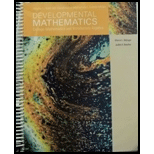
To fill: The blanks for the statement “The positive square root is called the_______ square root.”
Answer to Problem 1VR
Solution:
The blanks for the statement “The positive square root is called the principle square root.”
Explanation of Solution
Given information:
The provided choices are:
Principal, Pythagorean, Radical, Legs, Square, Radicands, Hypotenuse, Conjugates, Root,
Rationalizing
Explanation:
Consider the square roots.
According to the definition, a number b is said to be the square root of the number a if it satisfies the equation
All positive numbers possess two square roots, one positive and a negative denoted by the radical symbol,
The positive square root is also known as the principle square root.
For example:
Consider the expression
Since,
Thus, the square roots of
Hence, the blanks for the statement “The positive square root is called the principle square root.”
Want to see more full solutions like this?
Chapter 14 Solutions
DEVELOP.MATH(3 VOLS) CUSTOM-W/MML <IC<
- vide 0. OMS its 150MAS 40k 300mts 46KV 4). A technique is taken with 100 mA, 200 ms, 60 kV and produces 200 mSv. Find the intensity in rem when this technique is changed to 200 mA, 400 ms, 69 kV? nd 5). The dose to the body was 200 mSy. Findarrow_forwardGenesis Ward #9) A good exposure is taken using a technique of 12 mAs, 200 cm SSD,40kv, table top, and produces an EI value of 400 with a TEI value of 500. Find the new mAs value required to set DI=0, if a 100 cm SSD,34kV and a 6:1 grid were substituted. 12 MAS, 200cm SSD, 40kv E1 = 400 TEL = 500 of a radiograph was 100 mSv with a technique of: 10 mAs, 180 kV at 200 cm and 2 IV at 00 cm using a 5:1 grid then find thearrow_forwardExplain the key points of 11.5.2arrow_forward
 Algebra: Structure And Method, Book 1AlgebraISBN:9780395977224Author:Richard G. Brown, Mary P. Dolciani, Robert H. Sorgenfrey, William L. ColePublisher:McDougal LittellAlgebra & Trigonometry with Analytic GeometryAlgebraISBN:9781133382119Author:SwokowskiPublisher:Cengage
Algebra: Structure And Method, Book 1AlgebraISBN:9780395977224Author:Richard G. Brown, Mary P. Dolciani, Robert H. Sorgenfrey, William L. ColePublisher:McDougal LittellAlgebra & Trigonometry with Analytic GeometryAlgebraISBN:9781133382119Author:SwokowskiPublisher:Cengage Mathematics For Machine TechnologyAdvanced MathISBN:9781337798310Author:Peterson, John.Publisher:Cengage Learning,
Mathematics For Machine TechnologyAdvanced MathISBN:9781337798310Author:Peterson, John.Publisher:Cengage Learning, Holt Mcdougal Larson Pre-algebra: Student Edition...AlgebraISBN:9780547587776Author:HOLT MCDOUGALPublisher:HOLT MCDOUGAL
Holt Mcdougal Larson Pre-algebra: Student Edition...AlgebraISBN:9780547587776Author:HOLT MCDOUGALPublisher:HOLT MCDOUGAL Elementary AlgebraAlgebraISBN:9780998625713Author:Lynn Marecek, MaryAnne Anthony-SmithPublisher:OpenStax - Rice University
Elementary AlgebraAlgebraISBN:9780998625713Author:Lynn Marecek, MaryAnne Anthony-SmithPublisher:OpenStax - Rice University College AlgebraAlgebraISBN:9781305115545Author:James Stewart, Lothar Redlin, Saleem WatsonPublisher:Cengage Learning
College AlgebraAlgebraISBN:9781305115545Author:James Stewart, Lothar Redlin, Saleem WatsonPublisher:Cengage Learning





